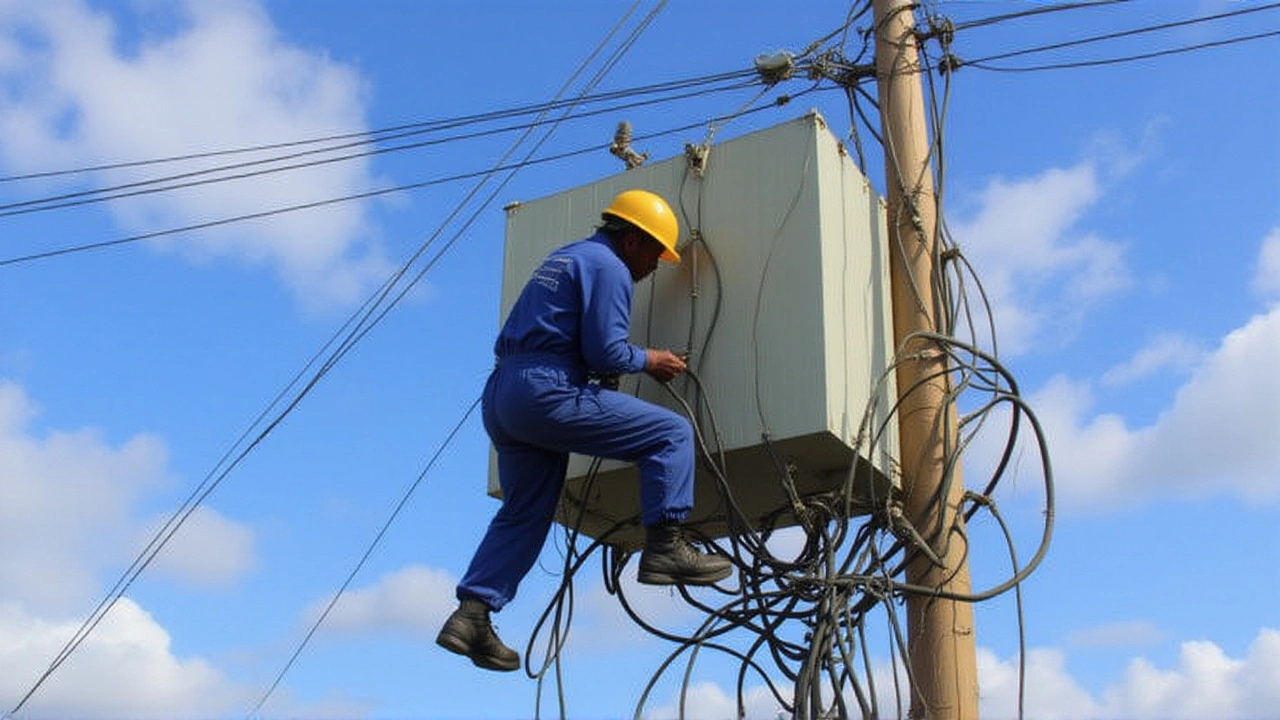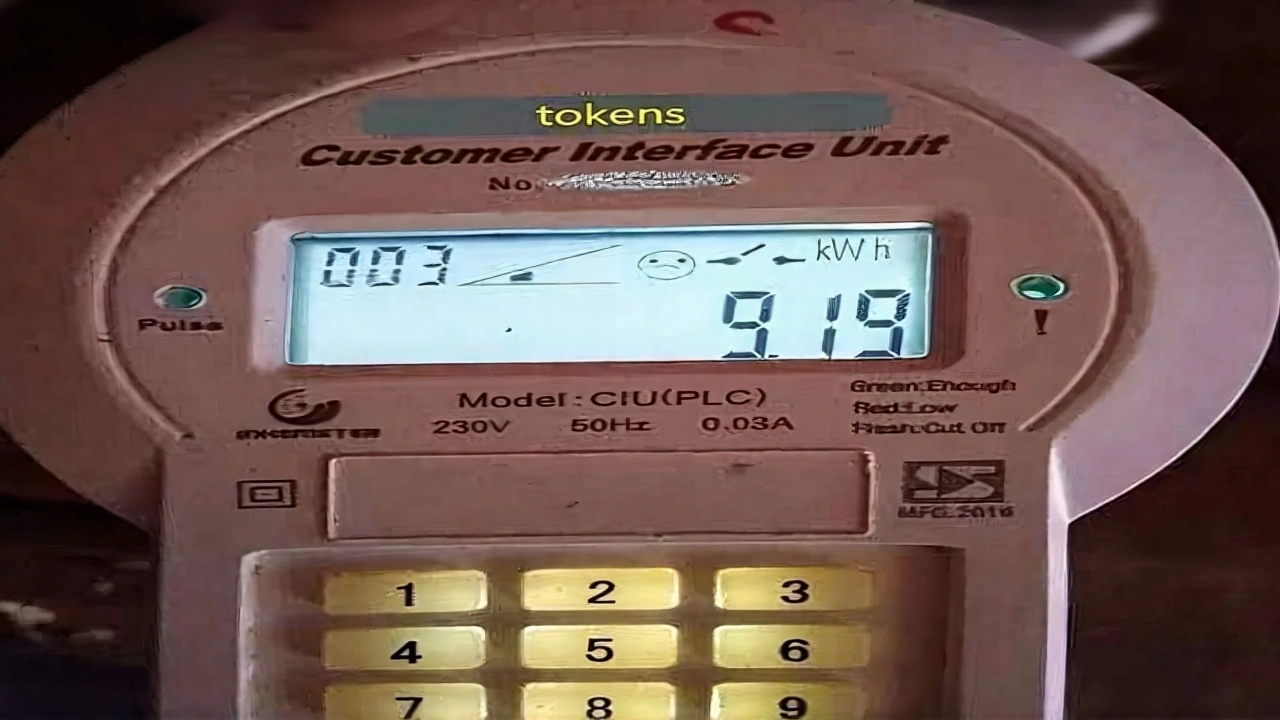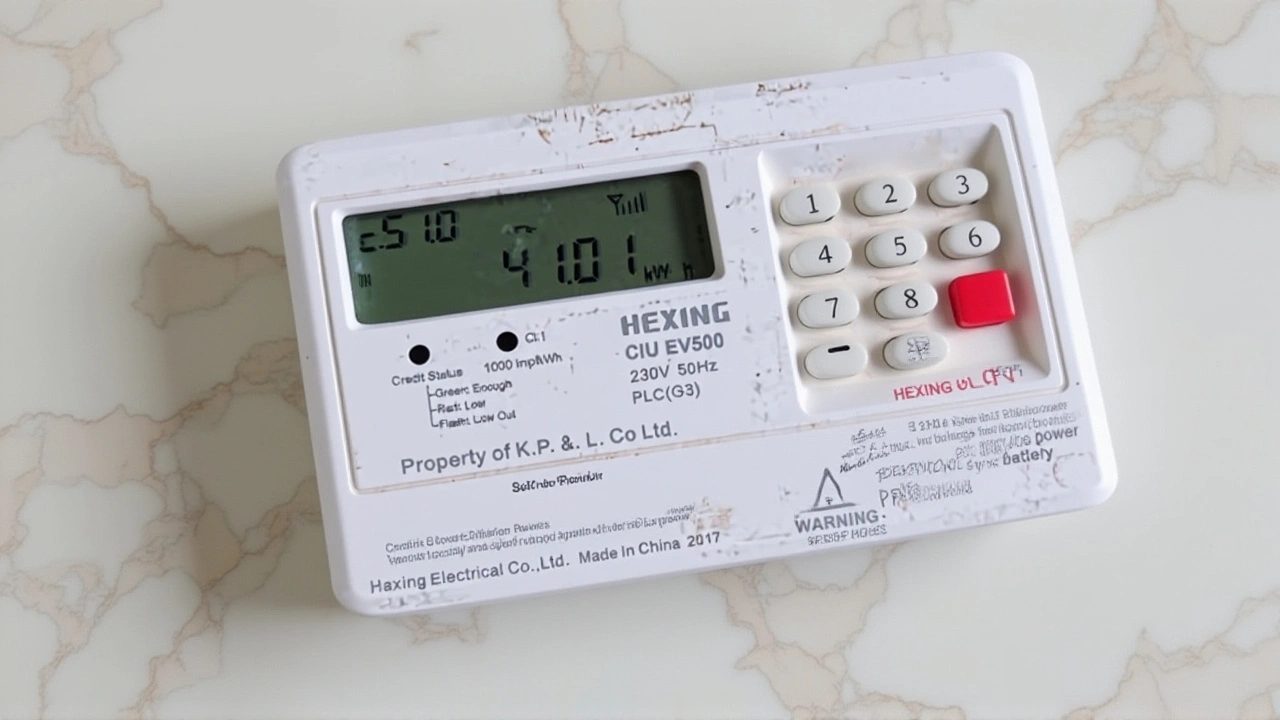When Kenya Power and Lighting Company (KPLC) announced the nationwide rollout of its digital prepaid electricity meters, households suddenly found themselves staring at a string of mysterious codes on their new displays.
The rollout, which kicked off in early March 2025 across Kenya, aims to replace the aging post‑paid meters that have long been blamed for billing glitches. By the end of August 2025, KPLC expects every residential and commercial connection to have been upgraded, and with the upgrade comes a set of “secret” operational shortcuts that let consumers peek at consumption data, balances, and even reset the device.
Background: Kenya’s Shift to Prepaid Electricity
Kenya’s power sector has been on a digital fast‑track since the government’s 2018 Energy Act called for a “prepaid‑first” strategy. The idea was simple: let users buy electricity before they use it, thereby eliminating debt spirals that plague many utilities in Africa.
According to KPLC’s own figures released on 12 May 2025, more than 1.8 million prepaid meters have already been installed, up from just 600 000 three years earlier. The target is 4 million by December 2025, covering roughly 75 % of the nation’s 5.3 million electricity connections.
“Prepaid meters give people real‑time control over their bills,” said Samuel Mwangi, senior communications officer at KPLC, in a press briefing on 15 May. “When you see the kilowatt‑hour reading on the screen, you instantly know whether you’re over‑using or saving.”
How the Secret Codes Work Across Meter Brands
The new meters come from several manufacturers, each with its own dialing syntax. Below is a quick cheat‑sheet that KPLC has circulated to help users avoid accidental lock‑outs.
- Conlog meters: Type
#100#and press Enter. - Actaris meters: Enter
100followed by the Enter key. - Hexing meters (including the popular Yaka Prepaid Meter Hexing CIU EV500): Press
804#then the blue key. - All other variations: Use the generic code
65.
For Hexing users, there’s a deeper menu that reveals consumption details:
Q800– Total active forward energy (cumulative kWh since installation).Q801– Current credit balance in Kenyan shillings.Q802– Current date stored on the meter.
The shortcodes are saved in the meter’s firmware, so they work even if the device has lost power or been moved to a new premises.
Step‑by‑Step: Updating Your Meter Before the August Deadline
KPLC is handling the upgrade in phases, sending two 20‑digit codes via SMS each time a customer purchases a token. The process looks like this:
- Buy a prepaid token as usual – either online, through a vendor, or via the *977# USSD menu.
- When the meter is scheduled for an update, the SMS with the reset code and update code arrives automatically, regardless of whether the token purchaser is the tenant or the landlord.
- Enter the 20‑digit reset code on the meter’s keypad, exactly as you would type a token.
- Follow with the 20‑digit update code.
- Test the meter by loading another token; a successful acceptance means the update went through.
If the token is rejected after three tries, KPLC advises callers to dial the national contact centre at 97771 or use the *977# USSD shortcut to request a fresh code.
“The update is free of charge, but we ask customers to ensure all previously bought tokens are loaded before they start,” Mwangi added. “That prevents the meter from thinking it’s out of credit during the reset.”

Customer Support Channels and Common Issues
Aside from the 97771 call centre, KPLC operates two dedicated lines for prepaid services: 0703 070707 and 0732 170170. The *977# menu (USSD) also doubles as a recovery tool – after selecting option 1 (Prepaid Services) and then option 2 (Latest Token), users input their meter number, pay a 10 KSh airtime charge, and receive an SMS with the most recent token plus any reset or update codes.
Social media is another avenue. The utility’s official Facebook page (KenyaPowerLtd) and Twitter handle (@KenyaPower_Care) field day‑to‑day queries, often posting step‑by‑step screenshots.
Common pitfalls include:
- Entering the 20‑digit codes with spaces or hyphens – the meter reads only numeric characters.
- Using the wrong brand shortcut; a Conlog code on an Actaris meter does nothing.
- Running out of airtime before the *977# request completes – the system aborts the SMS dispatch.
When in doubt, the safest bet is to call 97771. The average hold time reported in September 2025 was 4 minutes, down from 9 minutes a year earlier, thanks to the new call‑centre software.
Implications for Energy Consumers and the Grid
From a consumer standpoint, the secret codes are more than a curiosity; they’re a window into energy habits. A study by the University of Nairobi’s Energy Research Centre, published on 2 July 2025, showed that households that regularly checked Q800 reduced their monthly consumption by an average of 12 % after three months.
For the grid, prepaid meters improve cash flow predictability. KPLC’s quarterly report for Q2 2025 noted a 7 % reduction in bad‑debt write‑offs compared with the same period in 2024, attributing the drop to the prepaid model.
“We’re seeing fewer blackouts caused by load‑shedding that was triggered by revenue shortfalls,” explained Dr. Aisha Njeri, a senior analyst at the Kenyan Energy Regulatory Authority. “When users purchase electricity upfront, the utility can plan generation more accurately.”
However, critics warn that the transition could marginalise low‑income renters who rely on landlords to buy tokens. The KPLC SMS system, which sends codes to the purchaser’s number, may leave tenants without the necessary information if the landlord opts out of notifications.
In response, the regulator announced on 20 August 2025 that any prepaid account with a balance below 50 KSh must trigger an automatic SMS alert to both the meter‑owner and the registered account holder.
What’s Next: Future Features and Expansion
Looking ahead, KPLC is piloting a mobile‑app interface that will push real‑time alerts to smartphones, integrate with solar‑home‑systems, and allow users to set consumption caps.
The utility also plans to introduce a QR‑code token system by early 2026, which would let customers scan a code at a kiosk instead of typing a 20‑digit number.
All eyes are on the August deadline – not just for compliance, but as a litmus test of whether Kenya’s ambitious prepaid agenda can truly deliver on its promise of affordable, reliable power for everyone.

Frequently Asked Questions
How do I know which brand of prepaid meter I have?
Look at the front of the display – the brand name (Conlog, Actaris, Hexing) is usually printed above the keypad. If the label is worn, you can dial #100# for Conlog or 100 for Actaris; the meter will flash a unique pattern confirming the make.
What should I do if the 20‑digit reset code fails?
First, double‑check you entered the numbers without spaces. If it still fails after three attempts, call KPLC’s prepaid line at 0703 070707 or use the *977# USSD menu to request a new code. Keep your latest token handy, as the call‑centre may ask for it.
Can tenants receive the reset codes if the meter is registered to the landlord?
Yes. KPLC automatically sends the reset and update codes with every token purchase, regardless of whose name appears on the account. Tenants buying tokens on their own mobile number will see the SMS, but it’s wise to confirm the landlord has also received a copy.
Is there a cost to retrieve lost tokens via *977#?
A small airtime charge of 10 KSh is deducted from the caller’s balance (a minimum of 15 KSh is required). The service sends an SMS with the latest token and any associated reset codes within minutes.
What are the benefits of using the Q800‑Q802 shortcuts?
They let you check cumulative energy use (Q800), current credit balance (Q801), and the meter’s date setting (Q802) without waiting for a token receipt. This real‑time data helps households monitor consumption trends and avoid unexpected outages.




ONE AGRI
September 30, 2025 AT 19:06It is utterly astounding how the government thrusts these digital meters upon us without a single transparent briefing, as if we were incapable of grasping any technical nuance. The so‑called "secret codes" feel more like a covert surveillance tool, subtly monitoring every flick of a light switch in our homes. One cannot ignore the echo of colonial control that reverberates when foreign tech giants dictate the terms of our energy consumption. Moreover, the rapid rollout disregards regional disparities, imposing a one‑size‑fits‑all solution on a nation as diverse as Kenya. It is a glaring reminder that progress, when stripped of genuine public consultation, becomes nothing more than an imposition.
Kiran Singh
October 1, 2025 AT 17:20Wow, this really helps! 🙌 Thanks for breaking down the codes so clearly! 😊
Balaji Srinivasan
October 2, 2025 AT 15:33Appreciate the practical tips, will try the Q800 shortcut soon.
Hariprasath P
October 3, 2025 AT 13:46i cant belive how many peopel are still clueless bout these misterious codes, its like they think the metter will just work on its own. the whole thing is kinda creepy, especially when u think about the hidden menues that no one talks about. honestly, i think they should publish the whole firmware source and let us tinker, but nope, they keep it secret. maybe they want to keep control in the hands of a few tech geeks, i dont know. any way, if you dnt know your brand, just try #100# and see what happens, you might be surprised.
Vibhor Jain
October 4, 2025 AT 12:00Sure, because nothing says "user‑friendly" like a 20‑digit code you have to type on a tiny keypad. 🙄
Priya Patil
October 5, 2025 AT 10:13Great summary! I’ve been waiting for a clear guide like this. The Q801 balance check alone saved me from an unexpected outage last week. Keep the info coming.
Maneesh Rajput Thakur
October 6, 2025 AT 08:26While the rollout is presented as a consumer‑friendly upgrade, one must consider the underlying data collection incentives. Every interaction with those "secret" shortcuts creates a digital footprint that can be aggregated by the utility-or even third‑party vendors-to model household behavior. This could pave the way for dynamic pricing schemes that disadvantage low‑income families. Moreover, the timing of the SMS dispatches coincides with the upcoming elections, raising questions about potential politicization of energy access. Transparency is essential, yet we see only glossy press releases.
Ashutosh Kumar Gupta
October 7, 2025 AT 06:40The drama of watching a meter flicker to life after a token is almost theatrical, but the real tragedy is the bureaucratic maze we must navigate. First you dare to press the hidden code, and then you’re told to call a line that makes you wait forever, only to be told to "retry". It feels like the system enjoys watching us wrestle with its riddles, savoring each sigh of frustration. Yet, amidst the chaos, there’s a strange satisfaction when the meter finally accepts the token-like conquering a small mountain.
fatima blakemore
October 8, 2025 AT 04:53It’s fascinating how a simple numeric display can become a mirror reflecting our consumption habits. When we pause to read the Q800 reading, we’re reminded that energy, like time, is finite. This gentle nudge toward mindfulness can foster a deeper respect for the resources that power our daily lives. May we use these tools not just for saving money, but for cultivating a more sustainable relationship with the world around us.
Swetha Brungi
October 9, 2025 AT 03:06Thinking about the broader impact, the data gathered from these meters could enable utilities to fine‑tune demand‑response programs, aligning supply with real‑time usage patterns. That said, privacy safeguards must evolve in step with technology, ensuring that personal consumption data isn’t misused for marketing or other non‑essential purposes.
deepika balodi
October 10, 2025 AT 01:20If you’re unsure of your meter brand, just try the generic code 65.
Rashi Jaiswal
October 10, 2025 AT 23:33Yo, this is super helpful! I tried the #100# on my Conlog and it worked like a charm. Thx for the heads up, keep the tips comin! (sry for any typos).
Himanshu Sanduja
October 11, 2025 AT 21:46Thanks for sharing! I’ve been a bit lost with the whole reset‑code process, but now it makes more sense. The step‑by‑step guide is spot on.
Rashi Nirmaan
October 12, 2025 AT 20:00It is incumbent upon the responsible authorities to ensure that the implementation of such technological measures does not infringe upon the fundamental rights of consumers, particularly with regard to transparency and equitable access. The promulgation of secret codes, while ostensibly benign, must be subjected to rigorous scrutiny to preclude any potential for abuse.
vikash kumar
October 13, 2025 AT 18:13The precision of the firmware embedded within these digital meters underscores the necessity for meticulous documentation, thereby facilitating both user autonomy and regulatory oversight.
Anurag Narayan Rai
October 14, 2025 AT 16:26The advent of digital prepaid meters in Kenya marks a pivotal juncture in the nation’s energy narrative, and the implications extend far beyond the mere convenience of token‑based consumption. Firstly, the granular data harvested via the Q800 to Q802 shortcuts affords households unprecedented visibility into their energy usage patterns, empowering them to make informed decisions that can translate into tangible cost savings. Secondly, from a macro‑economic perspective, the aggregation of such data across millions of connections creates a rich dataset that utilities can leverage to forecast demand with heightened accuracy, thereby optimizing generation schedules and reducing reliance on costly peaking plants. Thirdly, the integration of these meters with mobile platforms, such as the *977# USSD interface, aligns with Kenya’s broader digital transformation agenda, fostering a seamless user experience that bridges the gap between traditional energy services and contemporary fintech solutions. Moreover, the deployment timeline-spanning from March to August 2025-reflects a coordinated logistical effort that necessitates robust stakeholder collaboration, encompassing local distributors, meter manufacturers, and community outreach teams. It is essential, however, to recognize the social dimension of this transition; while prepaid models mitigate debt accumulation for many, they also introduce a potential equity challenge for low‑income renters who may lack direct control over token purchases. The regulator’s recent mandate to trigger low‑balance alerts for accounts under 50 KSh represents a commendable corrective measure, yet its efficacy will depend on diligent enforcement and public awareness. Additionally, the secret codes-though advertised as user tools-carry an undercurrent of opacity, raising legitimate concerns about data privacy and the potential for unauthorized firmware manipulation. Transparent communication regarding the purpose and scope of these shortcuts is crucial to maintain public trust. In the realm of future innovations, the envisaged mobile‑app interface and QR‑code token system herald a move toward even greater user empowerment, enabling real‑time alerts and frictionless transactions. As these technologies mature, they may also pave the way for integration with renewable energy assets, such as solar home systems, thereby supporting Kenya’s commitment to sustainable development. Ultimately, the success of this rollout will hinge on a delicate balance between technological sophistication, consumer education, and equitable access, ensuring that the promise of reliable, affordable power is realized for all strata of society.
Sandhya Mohan
October 15, 2025 AT 14:40Isn’t it intriguing how a simple set of numbers can open a portal to understanding our own habits? When we peek at the Q800, we’re essentially looking at a mirror that reflects how we live.
Prakash Dwivedi
October 16, 2025 AT 12:53The introduction of secret operational codes within Kenya’s prepaid meters undeniably enhances user agency, yet it simultaneously raises critical considerations regarding data security and user education. Clear, accessible guidance is paramount to ensure that consumers can harness these capabilities without unintended mishaps.